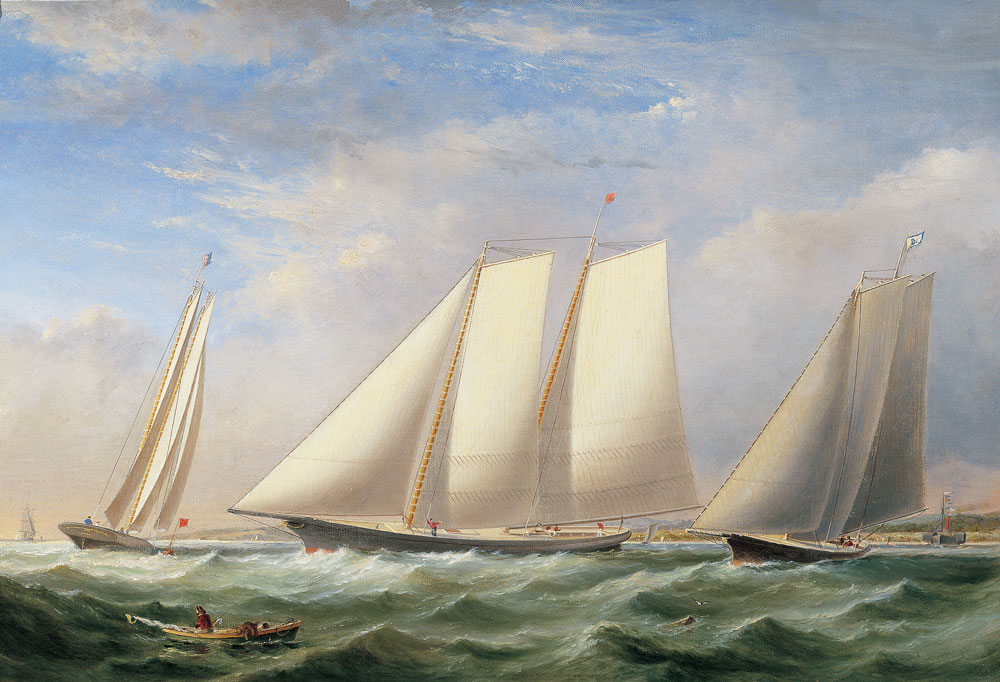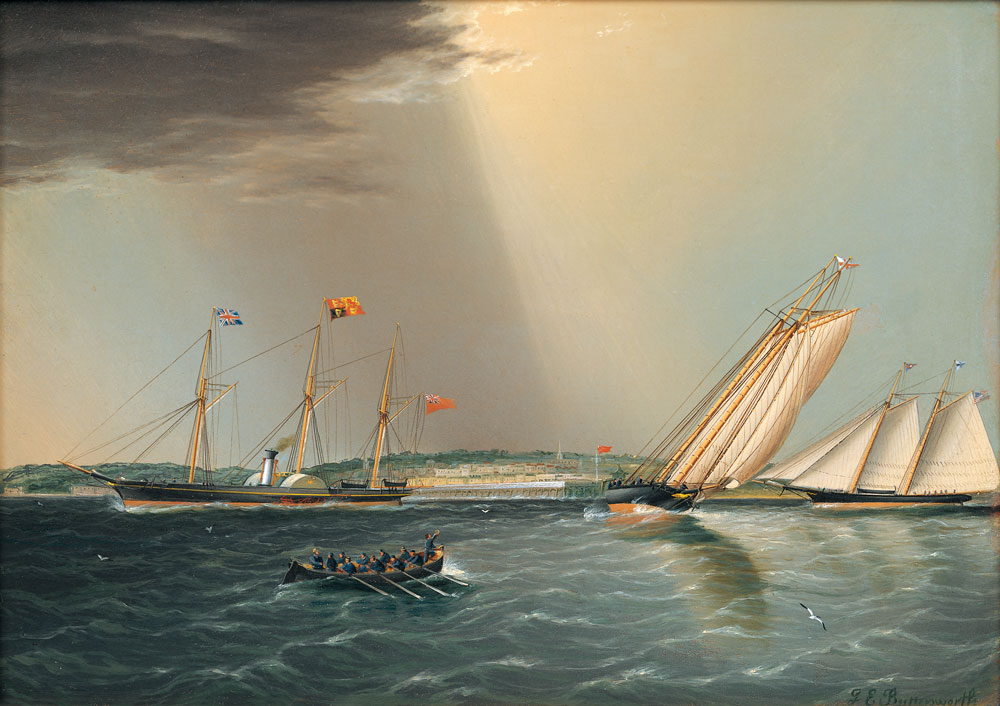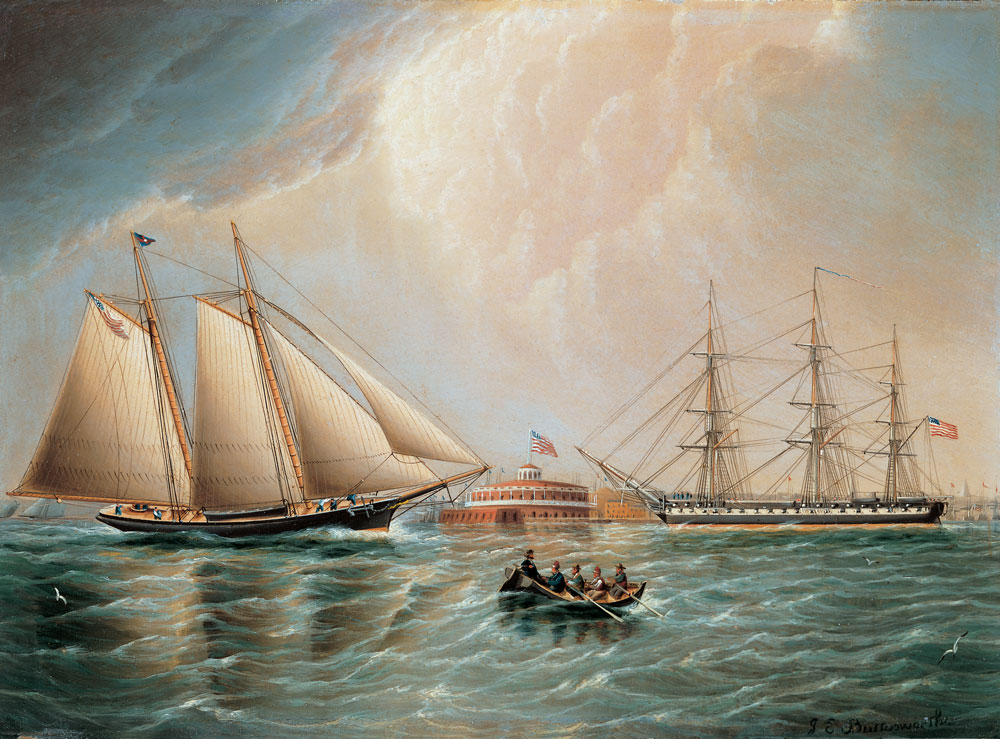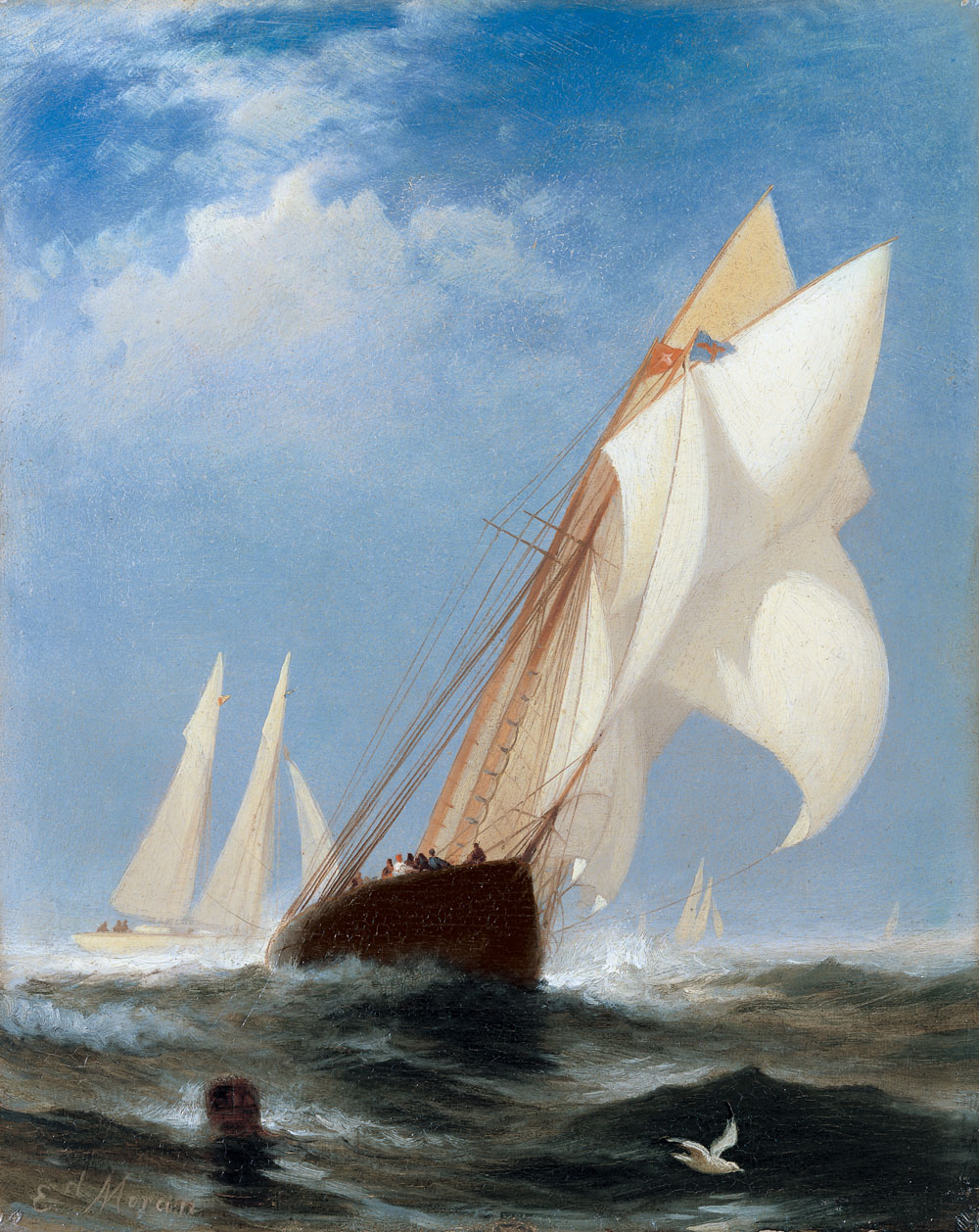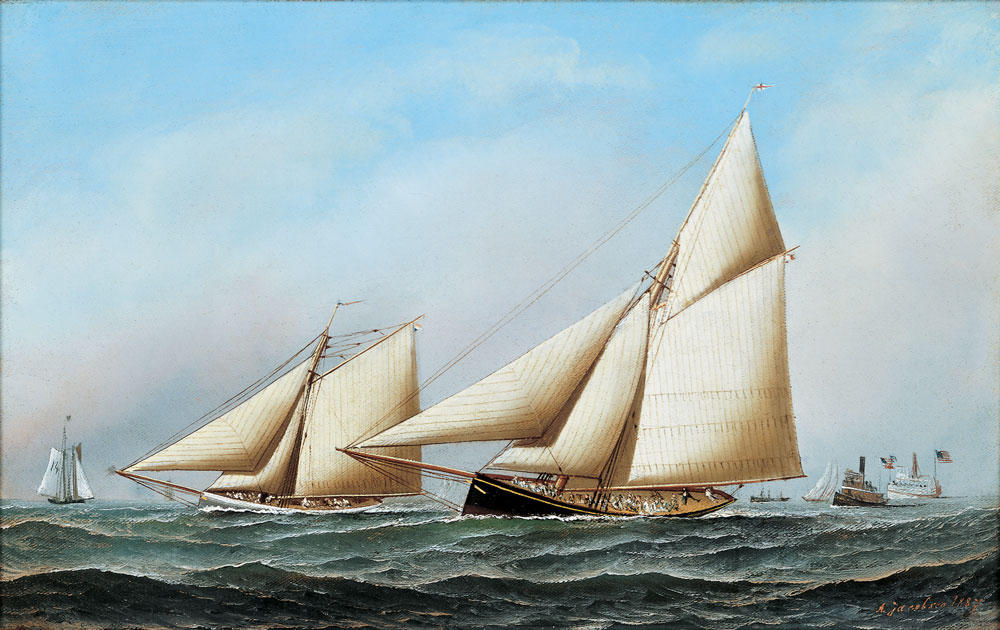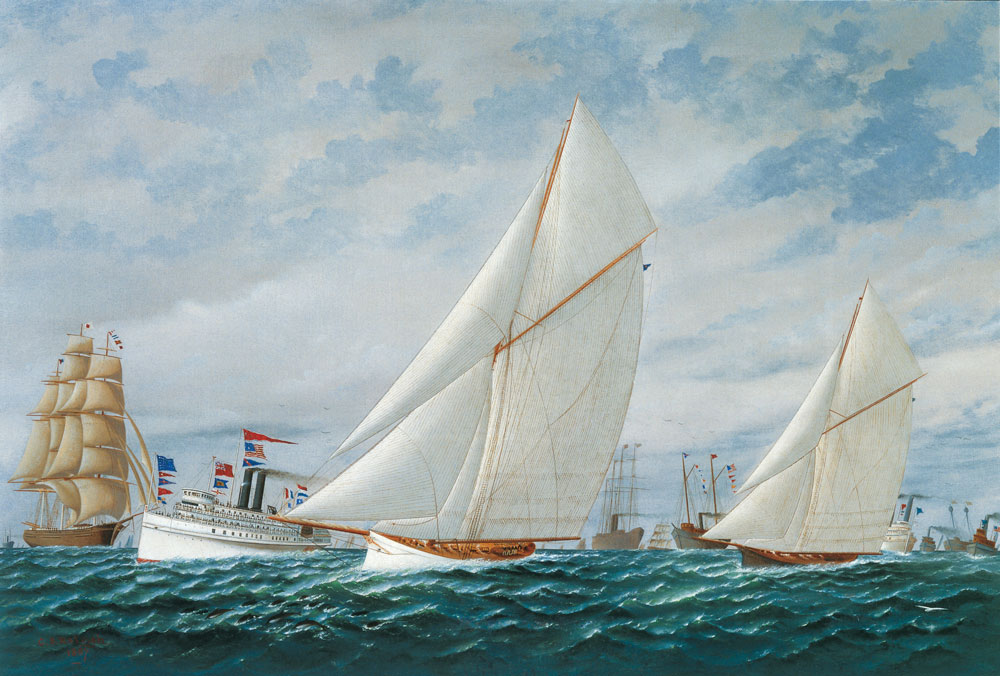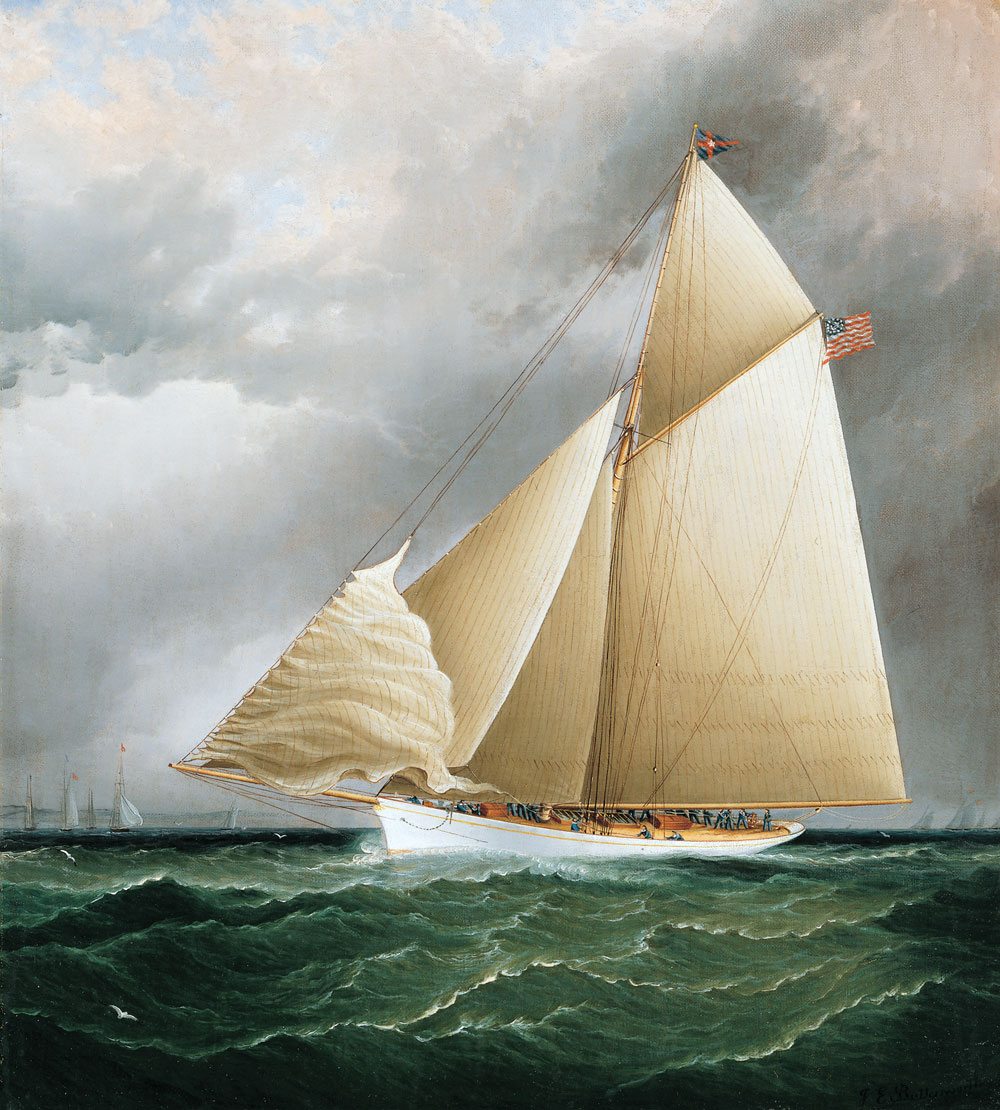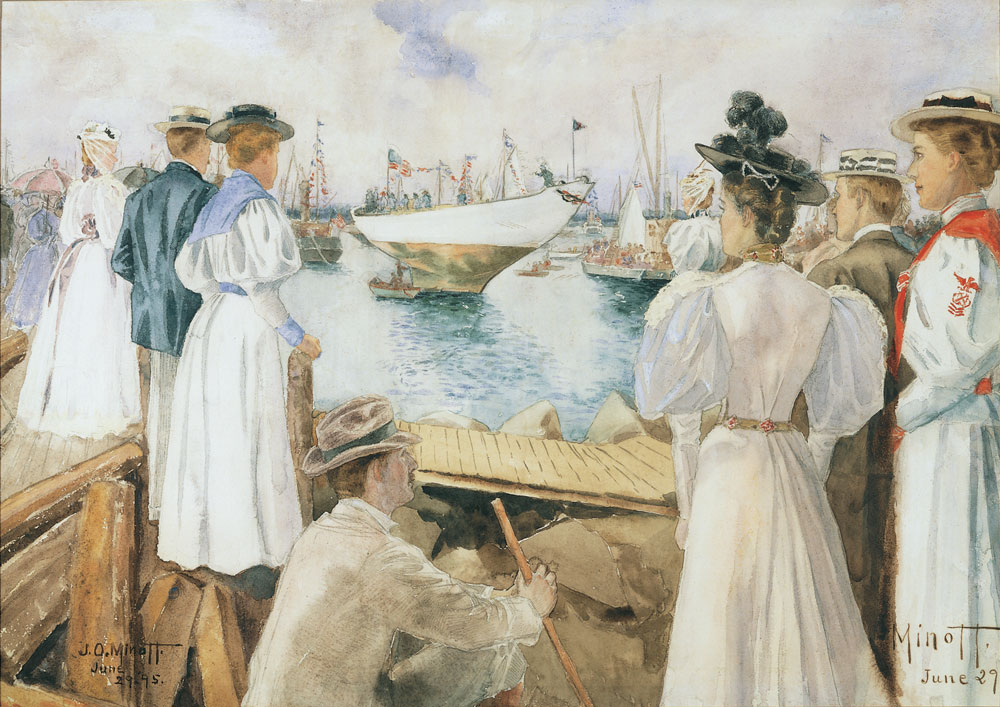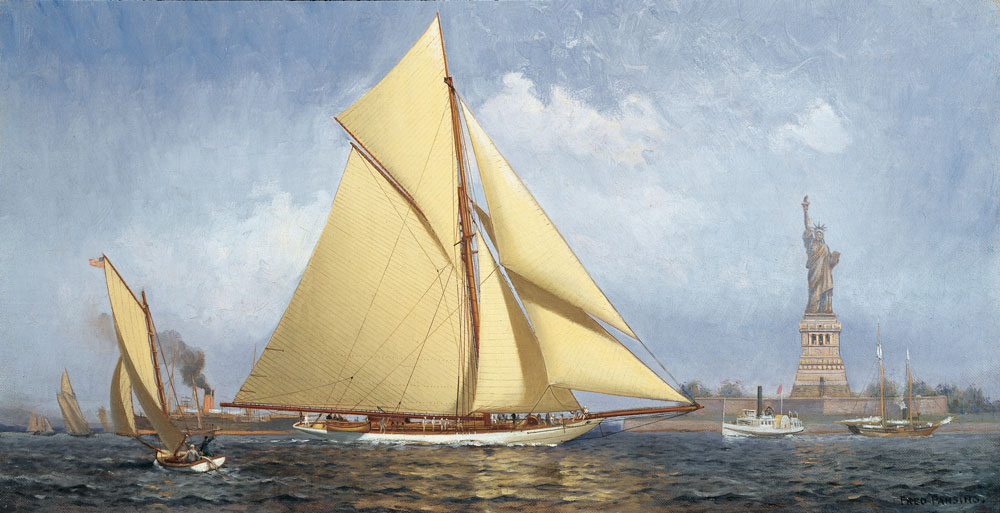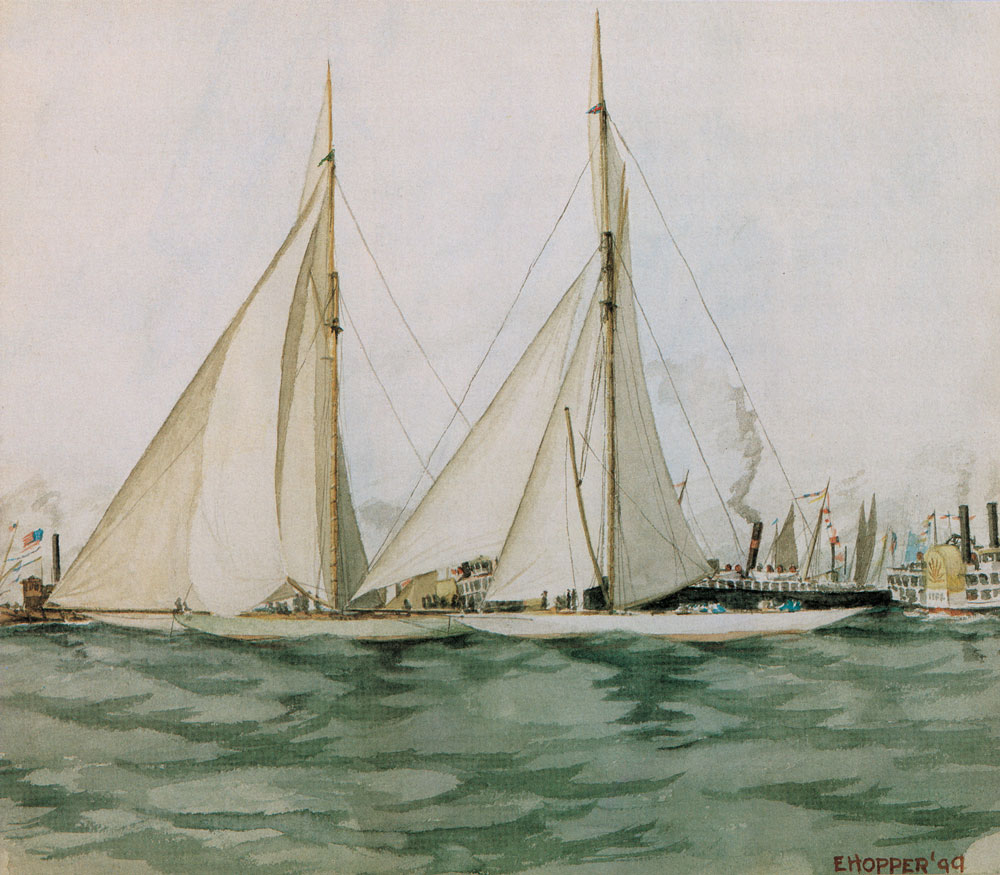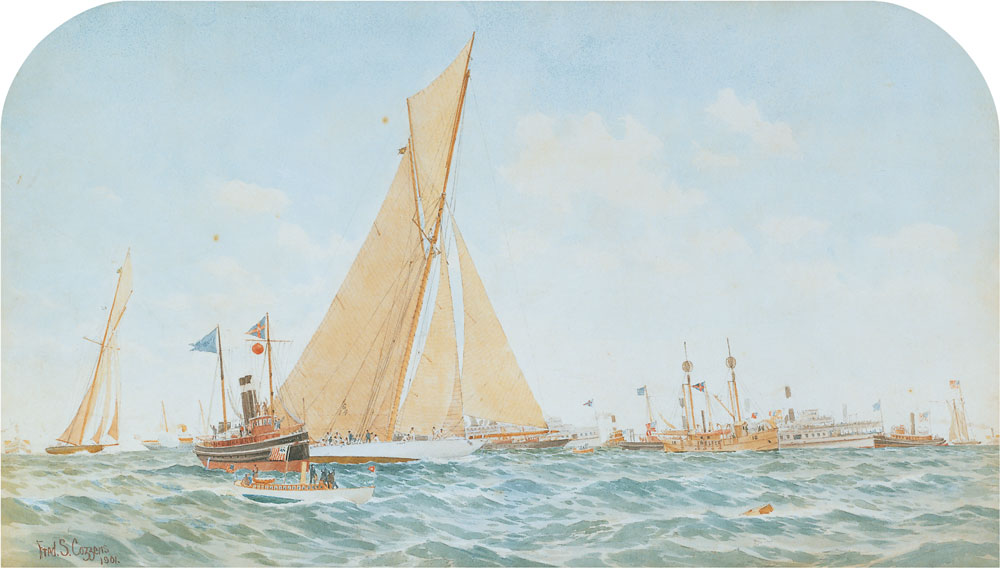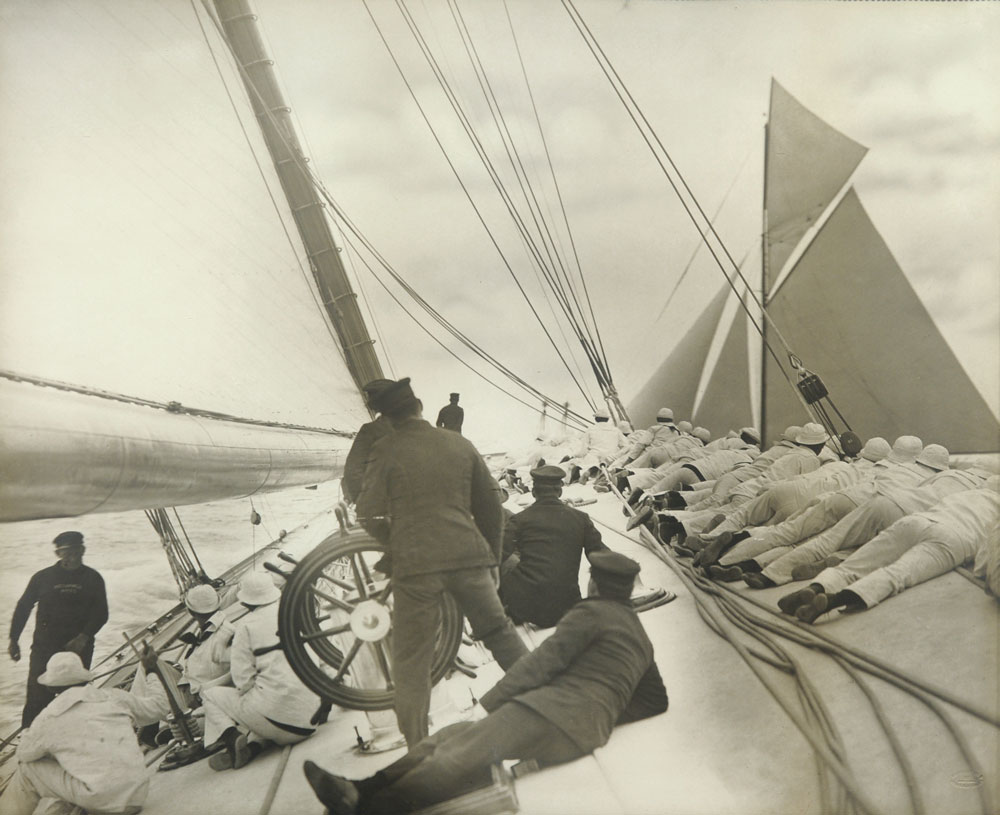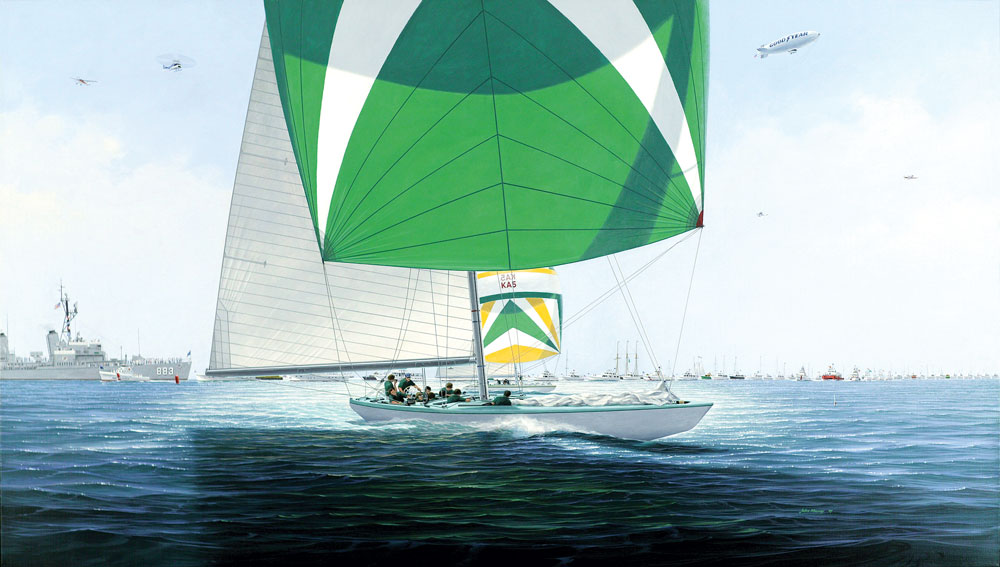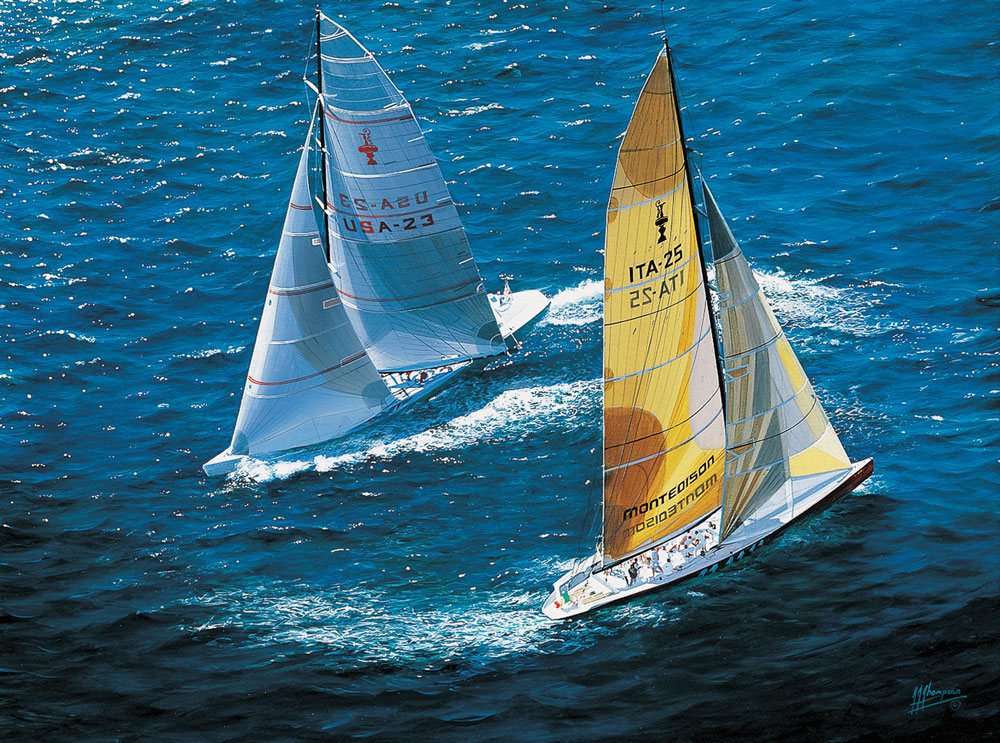The Art of the America's Cup
This archive article was originally published in the Summer/Autumn 2008 issue of Antiques & Fine Art magazine.
The America was the original muse for a cadre of nineteenth-century artists whose work inspired a tradition of marine artists documenting America's Cup races. In 1851, after the New York Yacht Club's schooner America won the Royal Yacht Squadron's Hundred Guinea Cup off the Isle of Wight, England, the race was renamed the America's Cup after the winning vessel. Since then, American vessels have won all but five Cup races and have become symbols of glory, sporting prowess, and patriotism. Marine artists such as James Buttersworth, Antonio Jacobsen, and Frederic Cozzens were among the first in a long line of distinguished artists of record the winning yachts, their designers, builders, captains, and owners.
Luminist painter Fitz Henry Lane (1804-1865), best known for his marine and landscape scenes suffused with almost tangible light and luxuriant color, depicted the America in Yacht America From Three Views, likely painted prior to her departure for England to race in the Hundred Guinea Cup. As artists often did in the first half of the nineteenth century, Lane presented the schooner yacht in three views (stern, profile, and angled). This painting of one of the most important yachts by one of the most important marine painters was, for many years, in the collection of the Herreshoff family, whose company, the Herreshoff Manufacturing Company, designed and built five consecutive America's Cup winners and won six of the races.1
James Buttersworth (1817-1894), a preeminent nineteenth century artist known for his depictions of the sport of yachting, painted the only picture known to exist of America racing in the 1851 Hundred Guinea Cup. A decade after the race, he painted The First America's Cup Race, in which the America is seen racing against the British yacht Aurora, while Queen Victoria watches the race from a vessel flying the Royal Standard. Queen Victoria is reported to have asked a nearby seaman which yacht was in second place, to which he responded somberly, 'Madame, there is no second,' America having won the race by such a large margin.
Buttersworth depicted the yacht again, this time against his favorite backdrop, New York Harbor, replete with such local landmarks as Castle Garden, after which the painting is titled. In this work Buttersworth took what he considered the most compelling details of America and coalesced them into his artistic vision of her. He depicts America as she was accessorized in 1851, flying her New York Yacht Club burgee and preparing to sail to England for the Hundred Guinea Race. She is rigged, however, as she was in the 1860s, following her salvage and refitting by the Union Navy, and as she raced in her first defense of the America's Cup in 1870.2
As other American yachts claimed victory in Cup races, they too were immortalized. Buttersworth's favored New York background appears again in Yacht Magic Off Battery of New York Harbor, circa 1871, in which Magic, winner of the America's Cup in 1870, dominates the canvas, while a race can be seen on its left-hand side. Such scenes underscore the growing prominence of yacht racing in America at the time, and especially in New York, whose New York Yacht Club won twenty-four consecutive America's Cup races.3
Buttersworth depicted two more successful defenders of the America's Cup in Yachts Madeline and Sappho, Off Sandy Hook Lightship. In the center of the canvas Madeline, who claimed victory in 1876, sails on a sharp starboard keel, in front of the red Sandy Hook Lightship, which is likely acting as a race marker. Sappho won the Cup in 1871. Edward Moran (1829-1901), the brother of well-known Hudson River School painter Thomas Moran (1837-1926), also painted the Madeline. In his dramatic composition Madeline leads the third America's Cup challenge in August 1876 against the Canadian vessel Countess of Dufferin.Madeline won handily 2-0 in the best of three racing series.4 The sailing action is almost tactile, with the winning Madeline seemingly about to erupt from the canvas.
Antonio Jacobsen (1850-1921), one of the most highly esteemed American marine artists, depicted the fifth America's Cup race in 1885, in which the American defender, Puritan, beat her British challenger twice, first in a thirty-two-mile race off New York and then in a second race off New Jersey's Scotland Lightship.5Puritan was the first of three America's Cup winners designed by Edward Burgess (1848-1891) and owned by the same syndicate headed by Charles J. Paine; Puritan was followed by Mayflower in 1886 and Volunteer in 1887. This is the only time in Cup history that a syndicate has won in three consecutive races. Jacobsen dramatized his composition and echoed the sentiments of the public by depicting the vast spectator fleet of vessels in the background, many of whom wave their American flags proudly in a show of patriotism.
The America's Cup race of 1887 — in which Volunteer successfully defended the seventh Cup race by a score of 2-0 in a best of three series against the Royal Yacht Club's challenger Thistle — was painted by multiple artists captivated by the drama and action of the race. Charles S. Raleigh (1830-1925) depicted the start of the race in Volunteer and Thistle, 1887. The painting was commissioned to be presented to Volunteer's syndicate after her victory. Raleigh brought the spectator fleet, overflowing with colored flags, into the action of the painting and closer to the viewer to emphasize the enthusiasm for the sport. Buttersworth also depicted the race in Volunteer.
Some artists chose to portray a yacht in a narrative moment outside of her racing context. Joseph Otis Minott (d. 1909), an obscure and obviously talented artist, captured a rare visage in Launching of Defender in 1895. Paintings of America's Cup yacht launches are virtually unheard of with the exception of this example. This image, showing the yacht framed by spectators, depicts the planned date of the launch, which, because the vessel got stuck, was actually delayed two days. Living up to her name, Defender would successfully defend the America's Cup that year against Valkyrie III by a score of 3-0 in a best of five series.
Fred Pansing (1844-1912) also painted Defender in a non-racing scene, sailing gracefully around lower Manhattan in Defender in New York Harbor, circa 1895. Pansing's perspective, which makes Defender appear to be dwarfing Lady Liberty, visually reinforces Defender's stature as the most famous yacht that year.
American realist painter Edward Hopper (1882-1967) explored the genre in his 1899 watercolor of the America's Cup winner Columbia. A yachting work by this well-known artist, who is not generally known as a marine painter, is extremely rare. Hopper portrayed the action of a race, the background teeming with spectator tugboats, steam sail vessels, and side-wheelers, among others. Three boats named Columbia raced in the America's Cup over an eighty-seven-year period.6 Hopper's Columbia, the second of the three, was a large sloop and one of only two boats to successfully win the Cup twice; winning in 1899 against Shamrock and again in 1901 against Shamrock II.7
Frederic Schiller Cozzens (1846-1928), famous for his yacht racing watercolors, portrayed the same Columbia in her second Cup victory. Completed within months of the September 1901 race, his watercolor, which was at one time in the Herreshoff collection, depicts Columbia winning the race before a highly detailed spectator fleet, which spills into the foreground between the racing yacht and viewer.
In 1903, photographer James Burton (active at the turn of the century) took what is likely the finest action photograph of a yachting race. This large, dynamic image was shot from the stern of Reliance, the 1903 defender and winner of the twelfth America's Cup, sailing toward the Sandy Hook Lightship. Reliance, also a Herreshoff yacht, was the largest yacht ever to compete in an America's Cup race and went undefeated in her short career. Captain Charlie Barr, one of the most renowned of all America's Cup captains, is at the helm, surrounded by the crew in white and the darkly clad afterguard (the decision-making members of the team). The challenger, Shamrock III, is poised to cross in front of Reliance's bow.
Contemporary artists continue the tradition of capturing likenesses of America's Cup competitors. Marine painter John Mecray painted Courageous, the winner — under Ted Turner — of the 1977 race, from memory on the thirtieth anniversary reunion of the crew. Courageous also successfully defended the Cup in 1974 under the leadership of Ted Hood. Australia, her 1977 competitor, is visible behind her in the center of the canvas. As in many nineteenth-century depictions, the spectator fleet is also visible, but so too are more contemporary elements such as the Goodyear blimp, helicopters, and motorized vessels.
The last American to win the race was the 1992 America's Cup captain and America3 (pronounced 'America cubed') syndicate leader Bill Koch, who commissioned marine painter Tim Thompson (b. 1951) to paint eight paintings documenting the races between America and her Italian challenger, Il Moro de Venezia. One of those paintings is an almost photorealist aerial view of the two yachts sailing on a glinting, blue sea. With such artists working today, it seems that the America's Cup — the oldest continuous sporting trophy in history — looks set to continue to be celebrated in paint.
-----
Alan Granby, who with his wife, Janice Hyland, founded Hyland Granby Antiques in 1976, specializing in museum quality eighteenth- and nineteenth-century maritime artifacts. He has also produced two maritime art books, A Yachtsman’s Eye and Maritime Maverick (www.hylandgranby.com).
Lauren Pheeney Della Monica is a New York City-based art advisor who works with clients to build collections of historical and contemporary work (www.lpdmfineart.com). The authors are presently working on a book, titled Flying the Colors, A History of 19th Century Marine Art Depicting American Ships.
This article was originally published in the Summer/Autumn 2008 issue of Antiques & Fine Art magazine. AFA is affiliated with Incollect.
2. An unpublished essay by Erik A.K. Ronnberg Jr. was the source for the information about this painting.
3. John Parkinson Jr., The History of the New York Yacht Club (The New York Yacht Club, 1975), Appendix XIII.
4. Unless otherwise cited, the America’s Cup website (www.americascup.com) was the source for information about the races in this article.
5. G.D. Dunlap, America’s Cup Defenders (New York: American Heritage Press, 1970), 32.
6. Herbert L. Stone and William H. Taylor, The America’s Cup Races (Princeton, N.J.: D. Van Nostrand Company, Inc., 1958), Appendix, “Record of America’s Cup Matches.”
7. Stone and Taylor, Appendix.















